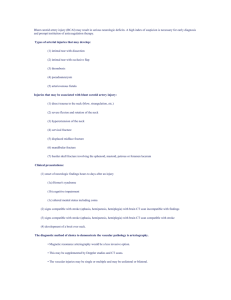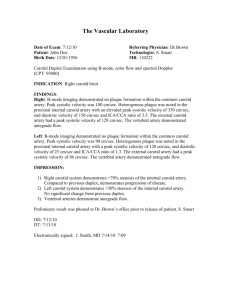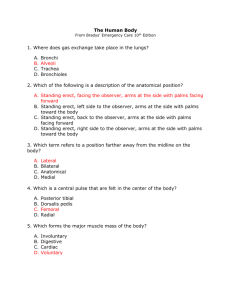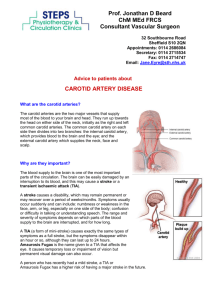Anatomical variations of the superior thyroid and superior laryngeal
advertisement
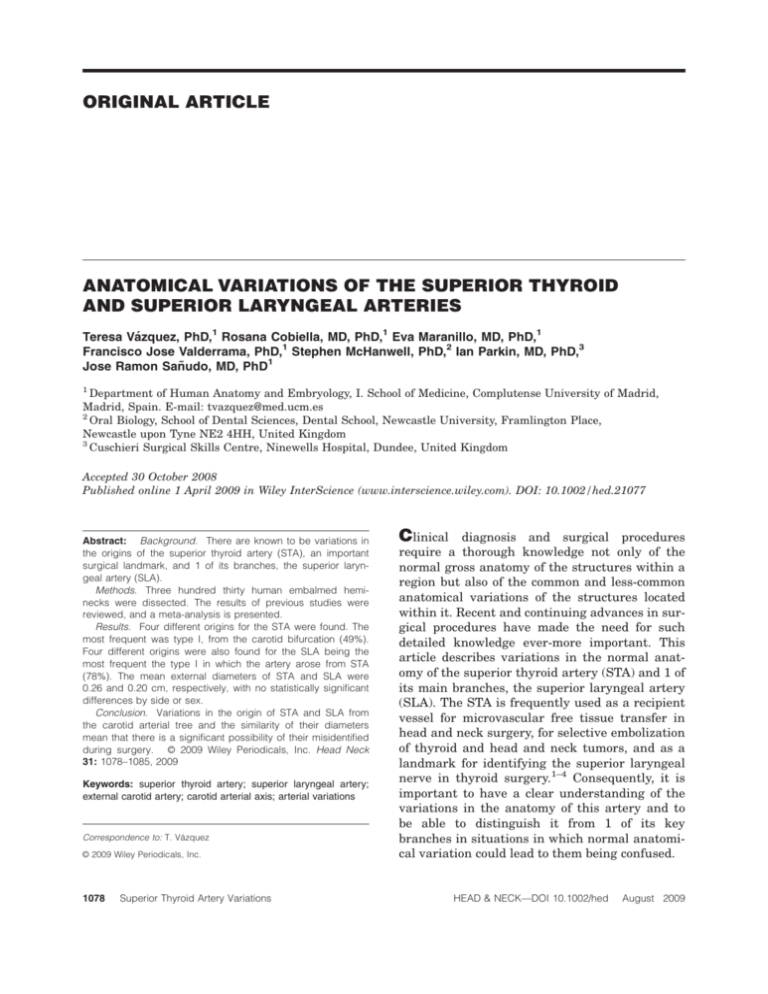
ORIGINAL ARTICLE ANATOMICAL VARIATIONS OF THE SUPERIOR THYROID AND SUPERIOR LARYNGEAL ARTERIES Teresa Vázquez, PhD,1 Rosana Cobiella, MD, PhD,1 Eva Maranillo, MD, PhD,1 Francisco Jose Valderrama, PhD,1 Stephen McHanwell, PhD,2 Ian Parkin, MD, PhD,3 Jose Ramon Sañudo, MD, PhD1 1 Department of Human Anatomy and Embryology, I. School of Medicine, Complutense University of Madrid, Madrid, Spain. E-mail: tvazquez@med.ucm.es 2 Oral Biology, School of Dental Sciences, Dental School, Newcastle University, Framlington Place, Newcastle upon Tyne NE2 4HH, United Kingdom 3 Cuschieri Surgical Skills Centre, Ninewells Hospital, Dundee, United Kingdom Accepted 30 October 2008 Published online 1 April 2009 in Wiley InterScience (www.interscience.wiley.com). DOI: 10.1002/hed.21077 Abstract: Background. There are known to be variations in the origins of the superior thyroid artery (STA), an important surgical landmark, and 1 of its branches, the superior laryngeal artery (SLA). Methods. Three hundred thirty human embalmed heminecks were dissected. The results of previous studies were reviewed, and a meta-analysis is presented. Results. Four different origins for the STA were found. The most frequent was type I, from the carotid bifurcation (49%). Four different origins were also found for the SLA being the most frequent the type I in which the artery arose from STA (78%). The mean external diameters of STA and SLA were 0.26 and 0.20 cm, respectively, with no statistically significant differences by side or sex. Conclusion. Variations in the origin of STA and SLA from the carotid arterial tree and the similarity of their diameters mean that there is a significant possibility of their misidentified C 2009 Wiley Periodicals, Inc. Head Neck during surgery. V 31: 1078–1085, 2009 Keywords: superior thyroid artery; superior laryngeal artery; external carotid artery; carotid arterial axis; arterial variations Correspondence to: T. Vázquez C 2009 Wiley Periodicals, Inc. V 1078 Superior Thyroid Artery Variations Clinical diagnosis and surgical procedures require a thorough knowledge not only of the normal gross anatomy of the structures within a region but also of the common and less-common anatomical variations of the structures located within it. Recent and continuing advances in surgical procedures have made the need for such detailed knowledge ever-more important. This article describes variations in the normal anatomy of the superior thyroid artery (STA) and 1 of its main branches, the superior laryngeal artery (SLA). The STA is frequently used as a recipient vessel for microvascular free tissue transfer in head and neck surgery, for selective embolization of thyroid and head and neck tumors, and as a landmark for identifying the superior laryngeal nerve in thyroid surgery.1–4 Consequently, it is important to have a clear understanding of the variations in the anatomy of this artery and to be able to distinguish it from 1 of its key branches in situations in which normal anatomical variation could lead to them being confused. HEAD & NECK—DOI 10.1002/hed August 2009 Table 1. Types of origin of superior thyroid artery based on incidence. No. of cases/total sample (%) Author Type I 8 Quain Livini10 Poynter11 Adachi12 Aaron and Chawaf14 (anatomical sample) Poissel and Golth15 Lucev18 Our results Meta-analysis 81/300 (27) 82/187 (44) 37/156 9/40 102/207 311/890 (24) (22) (49) (35) Type II 41/292 18/200 14/200 39/300 24/187 10/156 19/40 55/207 220/1582 Type III (14) (9) (7) (13) (13) 177/300 (59) 80/187 (43) (6) (47) (26.6) (14) 103/156 12/40 48/207 420/890 (66) (30) (23) (47) Type IVa 2/302 3/200 1/200 6/300 11/187 Type IVb (1) (1) (1) (2) (6) (0) 5/156 (3) (1) 2/300 (1) 30/1645 (2) 1/300 (0) (0) Comparison with consulted bibliography. Type I, origin from carotid bifurcation; type II, origin from common carotid artery; type III, origin from external carotid artery; type IVa, thyrolingual trunks; type IVb: thyrolinguofacial trunks. origins of the STA or SLA from the carotid arterial tree. We consider these earlier classifications difficult to apply in a clinical setting, and so have attempted to devise a simple classification that is easier and more useful to employ in surgical practice. Furthermore, some angiographic procedures require more complete quantitative information about certain parameters, including the diameters of their branches and distances of the origins of these arteries from carotid bifurcation. In the previous literature surveyed, these data are largely absent, with only 1 study providing data on the endoluminal diameter of the STA, which it gives as 2.5 mm.17 There have been no studies that provide information on the diameter of SLA. The aim of this study was to evaluate, in a large, statistically reliable sample of human cadavers, the normal anatomical variation in In the standard textbooks of anatomy or surgery, the STA is considered to have a relatively constant origin from the anterior surface of the external carotid artery (ECA); with the SLA originating from the STA as 1 of its major branches.5–7 However, within the literature, many different variations in origin have been reported for both arteries, including their arising from either of the other carotid arteries or arising from carotid arterial tree in common with other arterial trunks8–18 (Tables 1 and 2). Although some classifications of the variations in the anatomy of these arteries have been published, they are complex and elaborate, being based either on either the number of collateral branches arising from the STA or, more frequently, on the number and relative position of the collateral branches of the ECA.10,14 We have not found, in the literature surveyed, any classifications that are based exclusively on specific Table 2. Types of superior laryngeal artery origins based on incidence. No. of cases (%) Author 8 Quain Schwalbe and Pfitzner9 Livini10 Adachi12 Terracol and Guerrier13 Andrea16 Our results Meta-analysis Total sample 292 132 200 215 42 247 142 1270 Type I 266 92 175 198 29 232 111 1103 (91) (70) (72) (92) (69) (94) (78) (87) Type II 24 32 25 9 11 13 13 127 (8) (24) (12) (4) (26) (5) (9) (10) Type III Type IV 2 (1) 1 (1) – – 2 (5) – 7 (5) 12 (1) – – – – – – 6 (4) – Comparison with consulted bibliography. Type I, origin from the superior thyroid artery; type II, origin from external carotid artery; type III, origin from common carotid artery. Superior Thyroid Artery Variations HEAD & NECK—DOI 10.1002/hed August 2009 1079 FIGURE 1. Anterior views of isolated carotid arterial systems that show the superior thyroid artery possible origins. (A) Type I from the carotid bifurcation (49.3%); (B) Type II from the common carotid artery (26.6%); and (C) Type III from the external carotid artery (23.2%). ap, ascending pharyngeal artery; cc, common carotid artery; ec, external carotid artery; fa, facial artery; ic, internal carotid artery; la, lingual artery; oa, occipital artery; st, superior thyroid artery. the origins of the STA and SLA from the carotid arterial tree, 2 arteries that are of surgical importance. The rationale for this study been the lack of reliable information from previous studies. This study also reviewed the results of those earlier studies, performed a meta-analysis of their results, and compared them with the results obtained in this study. made using the chi-square test, with a value of p < .05 taken as a statistically significant one. Previous published results were carefully reviewed and compared to present a meta-analysis, and from the results in the present study, a unified and simple classification is proposed. RESULTS MATERIALS AND METHODS A total sample of 165 human cadavers (330 heminecks) embalmed at the Department of Anatomy, University of Cambridge, UK, was examined over a period of 4 years. The sex distribution was 74 men and 91 women cadavers, with an age range of 60 to 103 years. Clinical histories were available, and in no case contained any reference to vascular surgical intervention. Based upon the completeness of the neck structures after dissection, 3 different samples of the available cadavers were taken to study the following parameters: the origin and external diameter of the STA—207 heminecks (95 women and 112 women); the occurrences of the STA arising in common with other arteries—330 heminecks (148 men and 182 women); the origin and external diameter of the SLA—142 heminecks (63 men and 79 women). Distances and external diameters were measured with calipers. Statistical comparisons were 1080 Superior Thyroid Artery Variations The results show that the origins of the STA from the carotid arterial tree showed could be classified into 4 different types (see Figures 1 and 2). In 102 of the 207 cases with an incidence of 49%, the STA was found to arise at the level of the carotid bifurcation; this was classified as type I. In 55 of the 207 cases with an incidence of 27%, the STA was found to arise from the common carotid artery; this was classified as type II. Our data showed a statistically significant difference in type II origins between sides, with the frequency of occurrence being much higher on the left than the right (p ¼ .03). In contrast, there was no statistically significant difference in type II origins between men and women. In type III, the STA arose from ECA, and this was found to occur in 48 of the 207 cases; an incidence of 23%. A type IV origin for the STA was defined as being when the artery arose as a common trunk with 1 of more of the other branches of the carotid arterial tree. It was subdivided into type IVa, where the STA HEAD & NECK—DOI 10.1002/hed August 2009 FIGURE 2. Superior thyroid artery combined origins (type IV). (A) Left hemineck. Thyrolingual trunk from external carotid artery (type IVa). (B) Right hemineck. Thyrolingual trunk from common carotid artery (type IVa). (C) Left hemineck. Thyrolingualfacial trunk (type IVb), cb, carotid bifurcation; cc, common carotid artery; eln, external laryngeal nerve; ec, external carotid artery; fa, facial artery; h, hyoid bone; ic, internal carotid artery; iln, internal laryngeal nerve; la, lingual artery; oa, occipital artery; s, sympathetic trunk; sla, superior laryngeal artery; slv, superior laryngeal vein; st, superior thyroid artery; tc, thyroid cartilage; tg, thyroid gland; th, thyrohyoid muscle; tlt, thyroid-lingual trunk; XII, hipoglossal nerve. [Color figure can be viewed in the online issue, which is available at www.interscience.wiley.com.] arose with the lingual artery to form a common thyrolingual trunk. This was infrequent, occurring in just 2 of 330 cases; an incidence of 0.6%. In 1 type IVa case, the thyrolingual trunk arose from the ECA in a left hemineck (see Figure 3A), while in the other, it arose from the common carotid artery in a right hemineck (see Figure 3B). In type IVb origin was defined as where the STA arose in common, with the lingual and facial arteries forming a common thyrolinguofacial trunk. This was found in a single case (see Figure 3C). In those cases in which the STA originated from the carotid arterial tree as a single independent branch, it was found that there was a statistically significant difference between that originating from the carotid bifurcation (type I) compared to types II and III (p < .03) For the meta-analysis, incidences were calculated simply by dividing the number of cases of each origin by the number of cases. In calculating total incidences for types I and III, the results from some authors were excluded.8,10,11 This was because they failed to distinguish between arteries that arose from the carotid bifurcation and those that arose from the ECA itself. Also, the anatomical results of Aaron and Chawaf14 were included in the analysis (see Table 1). Superior Thyroid Artery Variations For the cases classified as type II origins, where the STA arose from the common carotid artery the distance from the origin of the STA to the carotid bifurcation was found to vary between 0.1 and 2.1 cm. In type III in which the artery originated from the ECA, the distance FIGURE 3. Distances to carotid bifurcation. ‘‘y’’ axis represents distance intervals in centimeters (cm); ‘‘x’’ axis represents percentages of cases belonging to each interval. Cases in which SLA arose from STA are not represented. Values under 0 include origins from common carotid artery: STA type II and SLA type III. Values below 0 include origins from external carotid artery: STA type III and SLA type II. Percentage corresponding to value 0 represents STA and SLA origins at carotid bifurcation level. HEAD & NECK—DOI 10.1002/hed August 2009 1081 FIGURE 4. Superior laryngeal artery possible origins. (A) Right hemineck. Type I; (B) Left hemineck. Type II, (C) Right hemineck. Type III. cb, carotid bifurcation; cc, common carotid artery; eln, external laryngeal nerve; ec, external carotid artery; fa, facial artery; h, hyoid bone; iln, internal laryngeal nerve; oh, omohyoid muscle; sh, sternohyoid muscle; sla, superior laryngeal artery; sm, sternothyroid muscle; smg, submandibular gland; st, superior thyroid artery; tc, thyroid cartilage; th, thyrohyoid muscle; tt, trunk formed by junction of thyroid, lingual, pharyngeal, and facial veins (Farabeuf trunk); XII, hipoglossal nerve; jv, jugular vein. [Color figure can be viewed in the online issue, which is available at www.interscience.wiley.com.] from origin to the carotid bifurcation varied between 0.1 and 1.5 cm (see Figure 3). In 1 case of the common thyrolingual trunk that originated, the ECA was found to arise just 0.3 cm above the bifurcation while the common thyrolingual trunk that arose from the common carotid artery did so 2 cm below the bifurcation. In the majority of cases for all types, the origin of the STA was found to be from the anterior face of the carotid arterial tree (95%, p ¼ .01). The external diameter of the STA was found to range from 0.1 to 1.5 cm, with a mean of 0.26 cm and a standard deviation of 0.12 cm. There were no statistically differences by sex or side. In a similar manner, the results on the origins of the SLA showed that these could be classified into 4 different types (see Figure 4). A type I origin was defined as where the SLA arose from the STA. This was by far the commonest type occurring in 111 of the 142 cases, an incidence of 78%. In this type, the distance between the origin of the SLA and the origin of the STA varied between 0 and 3.4 cm; but in most cases, the artery was found to arise 0.5 cm from the STA. In type II, the SLA arose from the ECA, and this was found in 13 of 142 cases (9%). In type III, the SLA arose from the common carotid artery, and this was found in 7 of 142 cases (5%). In type IV, the SLA arose from the carotid bifurcation, and this was found in 6 of 142 cases (4%). In a further 5 cases, the SLA was absent (4%). Type II and II origins were 1082 Superior Thyroid Artery Variations found to occur more frequently on the left than the right (p ¼ .06%). The distance of the origin of the artery from the carotid bifurcation ranged between 0.2 and 2.5 cm. Figure 1 shows the frequencies of distribution. The external diameter of the SLA was found to range from 0.1 to 1.5 cm, with a mean of 0.20 cm and a standard deviation of 0.19 cm. There were no statistically differences by sex or side. DISCUSSION Variations in the origins of the superior thyroid and superior laryngeal arteries have been reported by many authors,8–18 but there have been no previous studies that have attempted to classify the origins of these arteries that have been based exclusively upon their origins from the carotid arterial tree. From our own results and from our review of the literature, the origins of STA and SLA could, in each case, be classified into 4 patterns depending upon their site of origin from the carotid arterial tree. These classifications have enabled us to determine incidences for each origin, and this has enabled us to compare our results with those of previous authors and thus to present a metaanalysis of those studies with similar methodologies to our own (Tables 1 and 2). The normally reported pattern of origin of the STA describes it as arising from the ECA, HEAD & NECK—DOI 10.1002/hed August 2009 with the SLA arising as a collateral branch of the STA. This pattern is equivalent in our classification to a type III origin for the STA and a type I origin for the SLA. This accepted normal arrangement differs from our own observations on the origins of the STA, probably because earlier authors failed to distinguish clearly between an origin of the artery from the carotid bifurcation and an origin from ECA.8,10,11 We consider that this increased the incidence of reported origins from the ECA (type III in our classification). Although the meta-analysis shows a higher incidence of STA type III origin even when these earlier authors8,10,11 were excluded, the results of our work show that type III is the least frequently observed. From our results, the highest incidence is of type I, in which STA arises from carotid bifurcation (49%), while the frequency of occurrence of types II and III is almost equally distributed (26% and 23%, respectively). Cases in which STA originates in common with 1 or more arteries forming either a common thyrolingual or thyrolinguofacial trunk have been classified as type IV in our study. These have been described with a variable incidence by previous authors.7,8,12,14,15,17 Our results for these combined origins have been compared with those previously reported (Table 1) and are in disagreement with those obtained from our meta-analysis, in which previously a higher incidence has been reported. One of the thyrolingual trunks (type IVa) observed in the present study arose from the common carotid artery 2 cm below carotid bifurcation; such an origin has been only reported twice previously,19,20 in each case the origin being located 3 cm below the carotid bifurcation. A type IVb origin for the STA has been described only in sporadic cases.9,12,15 One report14 describes this situation in occurring in 2% of cases in a radiological sample, which is higher than we observed in our cadaveric sample (0.30%), although this could be due to the different methodology. This study14 as well as other studies relying upon data derived from radiological studies were excluded in the calculation of total incidence in meta-analysis for type IVa. There have been no previously reported data on type IVb cases to allow us to perform a metaanalysis. In the case of the SLA, all authors agree that its most frequent origin is from the STA, and the results of the systematic literature Superior Thyroid Artery Variations review show incidences only slightly different from those of our own observations of type I and II origins (see Table 2). There is, however, a much greater discrepancy in the reported frequencies of type III origin, which has only previously been reported by a few authors.8,9,13 Our results are similar to those of Terracol and Guerrier.13 A type IV origin, in which the SLA arises from carotid bifurcation, has not been previously described; previous authors may have considered this to have been a type II or III origin. There have been a few reports describing an origin for the SLA from the lingual artery or another, unspecified, artery,9,10,12,13,16 giving frequencies of occurrence between 0.7% and 5.10%. In our study, no cases were found in which the SLA arose from the lingual or any other arteries. In 5 cases, we found the SLA to be absent (3.5%), which represents the lowest reported incidence of this situation.10,16 Differences in origin for sex and side have only been described previously for the STA. The origin of the left STA was described as being located at a lower level than on the right,10 and the origin of the artery from the common carotid artery was described with a higher frequency on the left side and in women, though this study provides no quantitative results to support these statements.12 In our results, only statistically significant differences in origin with respect to side have been observed, the main differences we observe are that the STA arises from a common carotid artery with a higher frequency in the left side (p ¼ .03), and type II and III origins for the SLA are more frequent also on the left side (p ¼ .06). Only 1 report mentions the position of the origin of the STA in relation to the carotid axis,10 with this study describing its most frequent position as being at the internal face of carotid axis. However, in our study, the origin of the STA was located more frequently at the anterior face (95.2%).5,6 Although the origin of the superior thyroid artery has usually been described as being located very close to the carotid bifurcation,5,6 the exact value of this distance has been only once reported and with the reported distance ranging from between 1.5 cm below the bifurcation to 2.5 cm above it.10 In our study, we found that the origin of the STA varied from between 2 cm below the carotid bifurcation to 1.5 cm above it. In the case of type II origin for the HEAD & NECK—DOI 10.1002/hed August 2009 1083 STA, this was found to be at a mean distance of 0.7 cm, whereas that for the type III was found to be at a mean distance of 0.45 cm from the carotid bifurcation in each case (see Figure 1). The exact position of SLA on the carotid arterial axis, in cases in which the artery arises from ECA (type II), has been reported previously only once.10 Our results partially agree with that study in which the mean distance to the carotid bifurcation was very similar to the previously reported one (1.1 cm). In our sample, cases in which SLA arose from ECA (type II), did so at a distance 0.5 cm from the bifurcation, which means that the SLA arose in a similar area to that which might be expected for the origin of the type III STA (see Figure 1). Regarding the diameter of the STA, our results (mean value ¼ 0.26 cm) are in agreement with those of Czerwinski,17 who measured the STA endoluminal diameter in 240 cases. From the literature consulted, there appears to be no data about external diameter of the SLA, although a descending order for the diameter of the 16 collateral branches of the ECA has been previously described. In this previous report, the diameter of the STA was the third largest in size after the facial and lingual arteries,10 and SLA the smallest together with that of the sternocleidomastoid artery. In our results, STA was found to be the fourth largest vessel in diameter, after the facial, lingual, and occipital arteries. The range of diameters of the superior thyroid and superior laryngeal arteries were identical, and the mean diameters were similar, which means that it would be quite possible to confuse these 2 arteries in situations in which their origins are variable. Variations in the origin of the superior thyroid and superior laryngeal arteries could have important surgical repercussions. The STA is normally considered to be the first branch arising from the ECA and is used as a surgical landmark for differentiating the external from the internal carotid artery, since no cervical branches normally arise from the latter or from the carotid bifurcation.5–7 Our results show, however, that the possibility that the first artery arising from ECA or from carotid bifurcation is the SLA rather than STA always needs to be borne in mind. The accepted site of ECA ligation is inferior to the origin of the STA. However, its closeness to the carotid bifurcation may make this surgically difficult, and it is accepted that ligating 1084 Superior Thyroid Artery Variations above the STA may still preserve a good collateral circulation.5,21 Again, our results show that the variable origin of the STA and the fact that the SLA usually arises less than 1 cm from the ECA means that the STA is neither a reliable landmark for the identification of ECA nor to identify a safe point for its ligation. The only reliable method to identify ECA is that it would always be safer to identify several collateral branches of the ECA before carrying out this procedure on it.22 A further comment should also be made about the incidence of thyrolingual or thyrolinguofacial trunks (STA, types IVa and IVb). Although they are rare anatomical variations, they are yet further examples of variation in the expected pattern of branches of the ECA that may be encountered during surgery. Our proposed classification provides a means of classifying simply how the superior thyroid and superior laryngeal arteries arise in relation to carotid bifurcation, a site involved in many surgical procedures. Awareness of these variations and a careful examination is necessary before performing any invasive procedure and will allow the surgeon to define the vascular pattern and so avoid unexpected injuries. This study also highlights that the STA may not be considered as a constant surgical landmark for these procedures as may have been previously thought. CONCLUSIONS In the majority of cases (75%), the STA does not arise from ECA but from the common carotid artery, with this occurring more frequently on the left than on the right (p ¼ .03). A common thyrolingual trunk was present in 0.9% of cases and thyrolinguofacial trunks in 0.3% of cases. In 95.2% of cases (p < .01), the STA was found to arise from anterior aspect of the carotid arterial tree. The SLA was found to originate more frequently from STA (78.2%), although it was also observed arising from either the external or the common carotid arteries. Superior laryngeal arteries arising directly from either of these carotid arterial branches was observed more frequently on the left (p ¼ .06). When SLA was observed arising from ECA in most of the cases, it did so from an area where the STA might normally be expected to occur, and since both HEAD & NECK—DOI 10.1002/hed August 2009 arteries have similar external diameters, they could in such situations be easily confused. These results underline the importance for surgical practice of understanding these patterns of variation in situations where the STA is being used as a landmark, a recipient vessel or for selective embolization and emphasize the unreliability of the commonly accepted criteria for identifying this artery. Acknowledgment. Authors thank León for his valuable statistical advice. Dr. X. REFERENCES 1. Yazar S, Wei FC, Chen HC, et al. Selection of recipient vessels in double free-flap reconstruction of composite head and neck defects. Plast Reconstr Surg 2005;115: 1553–1561. 2. Terayama N, Sanada J, Matsui O, et al. Feeding artery of laryngeal and hypopharyngeal cancers: role of the superior thyroid artery in superselective intraarterial chemotherapy. Cardiovasc Intervent Radiol 2006;29:536–543. 3. Dedecjus M, Tazbir J, Kaurzel Z, Lewinski A, Strozyk G, Brzezinski J. Selective embolization of thyroid arteries as a preresctive and palliative treatment of thyroid cancer. Endocr Relat Cancer 2007;14:847–852. 4. Ozlugedik S, Acar HI, Apaydin N, Tekdemir I, Elhan A, Comert A. Surgical anatomy of the external branch of the superior laryngeal nerve. Clin Anat 2007;20:387– 391. 5. Hollinshead WH. Anatomy for surgeons: head and neck. London: Harper and Row; 1968. pp 458–460, 474–484. 6. Rouvière H, Delmas A. Anatomı́a humana (descriptiva, anatómica y funcional). Madrid: Masson; 1987. pp 205– 233. Superior Thyroid Artery Variations 7. Williams L, Warwick R, Dyson M, Bannister LH. Gray’s anatomy. London: Churchill-Livingstone; 1995. pp 310–314. 8. Quain R. The anatomy of the arteries of the human body. London: Taylor and Walton; 1844. pp 55–112. 9. Schwalbe G, Pfitzner W. Varietäten-Statistik und Anthropologie. Anat Anz 1891; Bd 4. Quoted by Adachi (1928). 10. Livini F. Le typs normal et les variations de l’A. carotis externa. Arch Ital Biol 1903;39:486–487. 11. Poynter CWM. Congenital anomalies of the arteries and veins of the human body with bibliography (doctoral thesis), Vol. 22. Lincoln: The University Studies of the University of Nebraska; 1922. pp 1–17. 12. Adachi B. Das arteriensystem der japaner. Kyoto: Maruzen Co; 1928. pp 54–82. 13. Terracol J, Guerrier Y. Le systéme artériel du larynx. Étude Anatomique. Montpellier Médicale 1951;41–42: 340–356. Quoted by Andrea M (1975). 14. Aaron C, Chawaf AR. Variations de la carotide externe et de ses branches. Bull Assoc Anat 1967;13:125–134. 15. Poisel S, Golth D. Variability of the large arteries in the carotid triangle. Wien Med Wochenschr 1974;15:229– 232. 16. Andrea M. VascularizaÇao arterial da laringe. DistribuÇao macro e microvascular (doctoral thesis). Lisbon: School of Medicine. Lisbon University; 1975. 17. Czerwinski F. Variability of the course of external carotid artery and its rami in man in the light of anatomical and radiological studies. Folia Morphol 1981;4:449– 454. 18. Lucev N, Bobinac D, Maric I, Drescik I. Variations of the great arteries in the carotid triangle. Otolaryngol Head Neck Surg 2000;122:590–591. 19. Vuillième J, Bruneton J. Le tronc thyrolingual artériel. Ann Anat Path Anat Norm Méd Chir 1932;9:686–689. Quoted by Lemaire et al (2001). 20. Lemaire V, Jacquemin G, Medot M, Fissette J. Thyrolingual trunk arising from the common carotid artery: a case report. Surg Radiol Anat 2001;23:135–137. 21. Guerrier Y. Traité de technique chirurgicale O.R.L. et cervico-faciale. 2nd ed. Paris: Masson; 1987. p 3. 22. Krompotic-Nemanic J. Surgical anatomy of head and neck. Berlin Heidelberg: Springer- Verlag; 1988. pp 22–39. HEAD & NECK—DOI 10.1002/hed August 2009 1085

